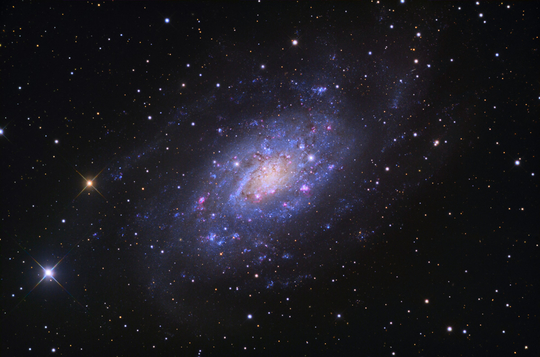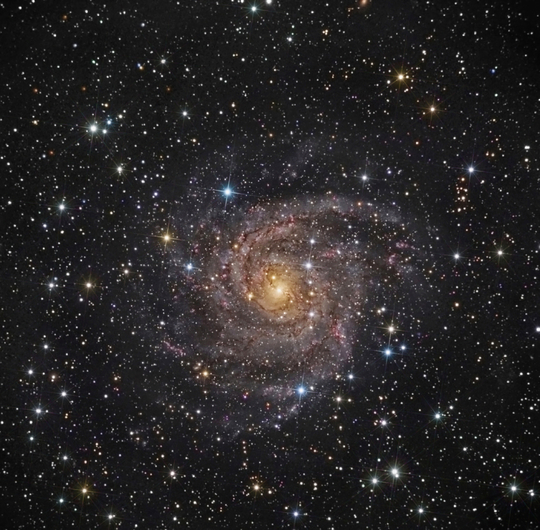Galaxy of the Month in Camelopardalis
-
IC 2184 in Camelopardalis
March 2019 - Galaxy of the Month
This interactive image of the IC 2184 was provided by the Pan-STARRS1 Surveys using Aladin Sky Atlas. This peculiar V shaped galaxy pair in Camelopardalis was first discovered in 1900 by Bigourdan using the 12.4” refractor in Paris.
Originally thought to be a single galaxy it was added into Vorontsov-Velyaminov’s catalogue of interacting galaxies as VV 644. Due to its bright emission in the UV/Blue bands it was also classified as Markarian 8.
There seemed to be a lot of confusion as to the nature of this object with some observers claiming there were four galaxies present. This mystery was cleared up when Hubble imaged the pair. The Hubble image shows distinct tidal tails as well as the massive star forming regions formed when the gas from the galaxies crashed into one another.
The presence of these star forming regions and the existence of many Wolf-Rayet stars has also led to IC 2184 being classified as a Wolf-Rayet galaxy. Wolf-Rayet (WR) galaxies are a subset of emission-line and HII galaxies, whose integrated spectra show broad emission features attributed to the presence of WR stars.
Images taken in H-Alpha show the existence of a number of bright knots, which are the starburst sites. These knots would appear to be immersed in a diffuse envelope. The rapid rate of star formation is indicated by the fact that one of the knots may have up to 850 WR stars in it. Given this the knots cannot be that old and their age has been estimated of to be of the order of 4-6 million years. The existence of these knots may be the reason that earlier observers thought there were more than two galaxies here.
From the Hubble image it would appear that we are pretty much seeing the galaxies edge on. The galaxies are perhaps 165 million light-years away and at this distance would be perhaps 45 and 40 thousand light-years across. The whole system is perhaps 65 thousand light-years across, so quite small galaxies. The pair will merge into a single galaxy and given their distance will have probably done so by now.
Visually this galaxy pair will be a challenge, not so much for their faintness as they are around 13th magnitude, but because of their size. They are quite small so you are going to need high power to separate the pair.
Perhaps not surprisingly IC 2184 does not make the standard references. Steve Gottlieb has quite an old observation in his IC notes which suggests that it was fairly faint with a 24” reflector and even at 375x he could not split the pair. I guess it has not made it onto the list for Jimi Lowery’s 48”. Uwe Glahn does have a nice drawing of the pair however with his 27” in the Interstellarum Field Guide.
Owen Brazell - Galaxy Section Director
-
January 2013 - Galaxy of the Month
NGC 2403
Image Courtesy of Adam Block/Mount Lemmon SkyCenter/University of Arizona. For more images from Adam Block please visit his website. You can click on image for a high resolution version, or download our Megastar© finder chart.
Camelopardalis is a large winding constellation with no bright stars. It does however have a number of interesting galaxies one of which, IC 342, we have already covered in a recent galaxy of the month piece.
NGC 2403 was discovered by William Herschel in 1788 and it is believed to be an outlying member of the M81 group. NGC 2403 appears to be the second largest galaxy in that group after M81.
In the larger picture NGC 2403 and the M81 group is part of the Coma-Sculptor cloud which includes our own Local Group and has a diameter of perhaps 10 Mpc across. The Coma-Sculptor cloud is part of the Virgo Cluster.
NGC 2403 was the first galaxy outside our local group to have Cepheid variables identified in it, in this case by Alan Sandage using the Mt Palomar 5m (200") telescope. His initial measurements placed the galaxy about 8000 light years away, far less than the current value. NGC 2403 is thought to be similar in size and shape to M33 being about 50,000 light years across and about 3.5 Mpc away.
It has had 3 supernovae in the last 70 years including one of the brightest in recent years in 2004. There is however a possibility that the supernova seen by Zwicky in 1954 was not a true supernova event but an eruption similar to that experienced by the LBV Eta Carina in the first part of the 19th century.
The galaxy has numerous large open stars clusters and HII regions as shown in this magnificent NASA APOD image which combines data from the HST and the 8m Subaru telescope. The cause of the star formation appears to have been a recent merger event possibly with NGC 2404, although this may just be a giant HII region and cluster in NGC 2403 similar to NGC 604 in M33. NGC2403 is classified as SAB(s)cd.
Dynamically the galaxy is of some interest as it seems to have the normal gas component in the disk but there appears to be evidence of large amounts of gas flowing into the disk from a halo, perhaps analogous to the high velocity clouds we see in our own galaxy, although here the amounts involved are much greater and could be part of the reason for the enhanced star formation.
Visually it is quite a bright object and can be seen in binoculars from a dark site however larger apertures are needed to see any detail. NGC 2403 also has one of the few extragalactic globular clusters that may be seen visually in F46, although a large telescope will be needed for this. Use of a UHC filter may also help to bring out the HII regions.
Owen Brazell - Galaxy Section Director
-
September 2012 - Galaxy of the Month
IC 342 in Camelopardalis
Image Courtesy of Ed Henry, Hay Creek Observatory, Augusta, WI. For more images from Ed please visit his Hay Creek Observatory website. Click on the image above for a high resolution version.
IC 342 was first discovered by the English astronomer W.F. Denning in 1890, although the observation was published two years later. Denning used a 10" reflector to discover IC342 and observed from Bristol. Although Denning was primarily known as a comet hunter but he also discovered a further 17 other objects that made their way into the IC catalogue.
IC342 was initially thought by Hubble to be part of our own local group of galaxies however recent measurements have shown it to be much further away with a distance of perhaps 7 million light years. This places it outside our own local group but it is one of the two brightest galaxies associated with the Maffei 1 group of galaxies, Maffei 1 being the other.
The IC342/Maffei 1 group is the nearest galaxy group to our own and has probably had an impact of the evolution of our own local group through its gravitational interaction.
Unfortunately IC 342 is located very close to the plane of the Milky Way so it is nowhere near as spectacular as it would be if its light was not so severely attenuated by the dust. An image of how the IC 342 might look if dust did not obscure it so heavily can be seen from an infrared image taken by the WISE satellite. A stunning visual image can be seen at NASA's APOD.
IC342 is inclined at an angle of 11 degrees to the line of sight and as such is almost face on. IC342 appears to be a large spiral galaxy similar to our own Milky Way and M31 and has several prominent HII regions in its spiral arms which suggests it has undergone a recent burst of star formation. Unusually perhaps the core of the galaxy also appears to have undergone a recent burst of star formation.
With the exception of the two Magellanic clouds IC 342 maybe the third largest galaxy in terms of angular size known, and the fact that IC 342 is both face on and large makes it a challenge for visual observers, think M101 but much harder. It maybe that only the core can be seen as this is fairly star like and to observe the diffuse halo will require very dark and transparent conditions.
Stephen O’Meara however claims to have seen it and its spiral arms with a 4" and to have seen the galaxy through 10x42 binoculars. Due to its size and faintness it maybe that the galaxy is better seen with low power rather than the higher powers normally used. Certainly I found it non trivial with a 22" at Kelling which perhaps tells its own story on the skies from the UK.
IC342 is however a fine target for imagers. There is a more distant galaxy nearby that may only be visible to owners of large telescopes and this is UGC 2826.
Owen Brazell - Galaxy Section Director

